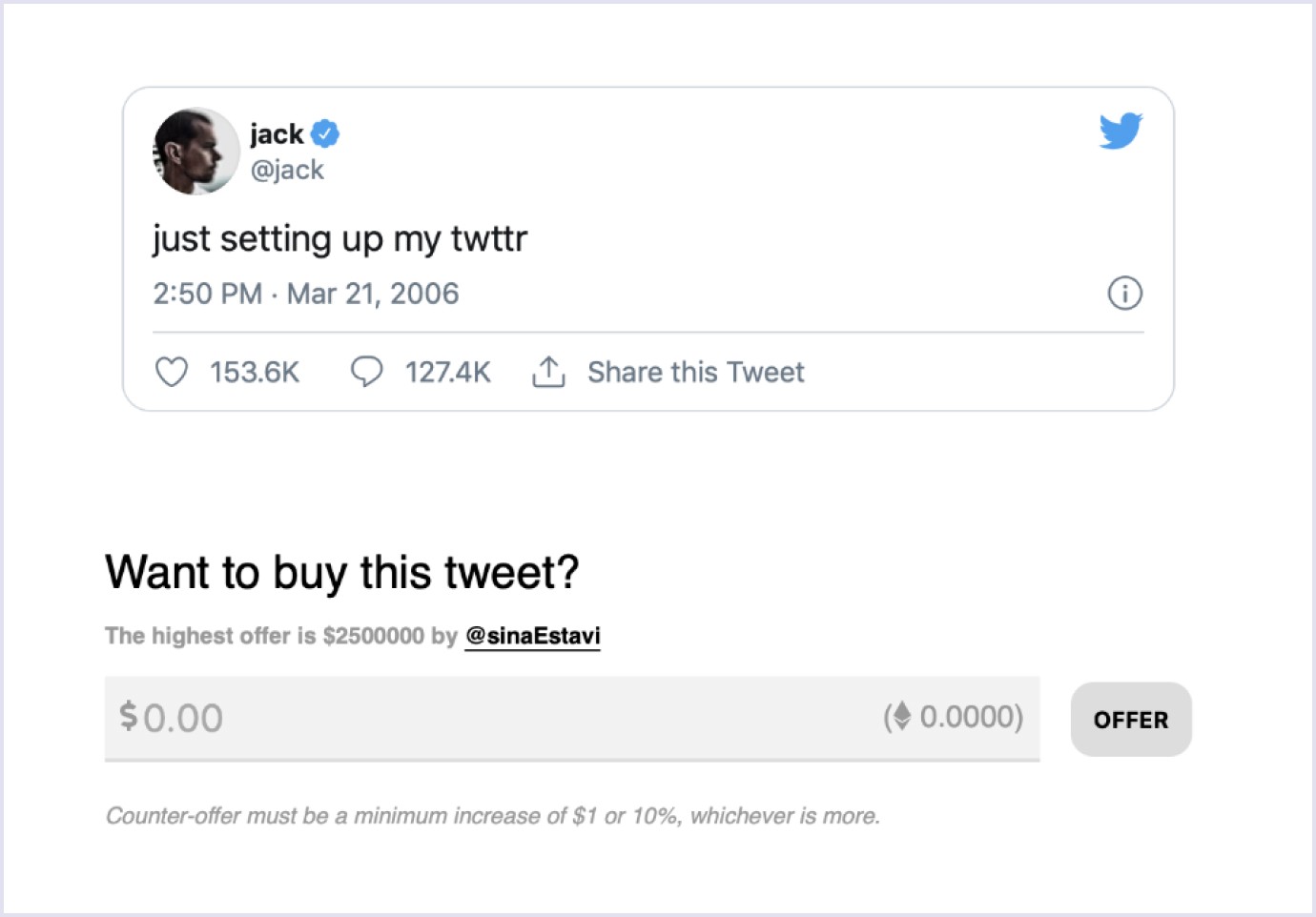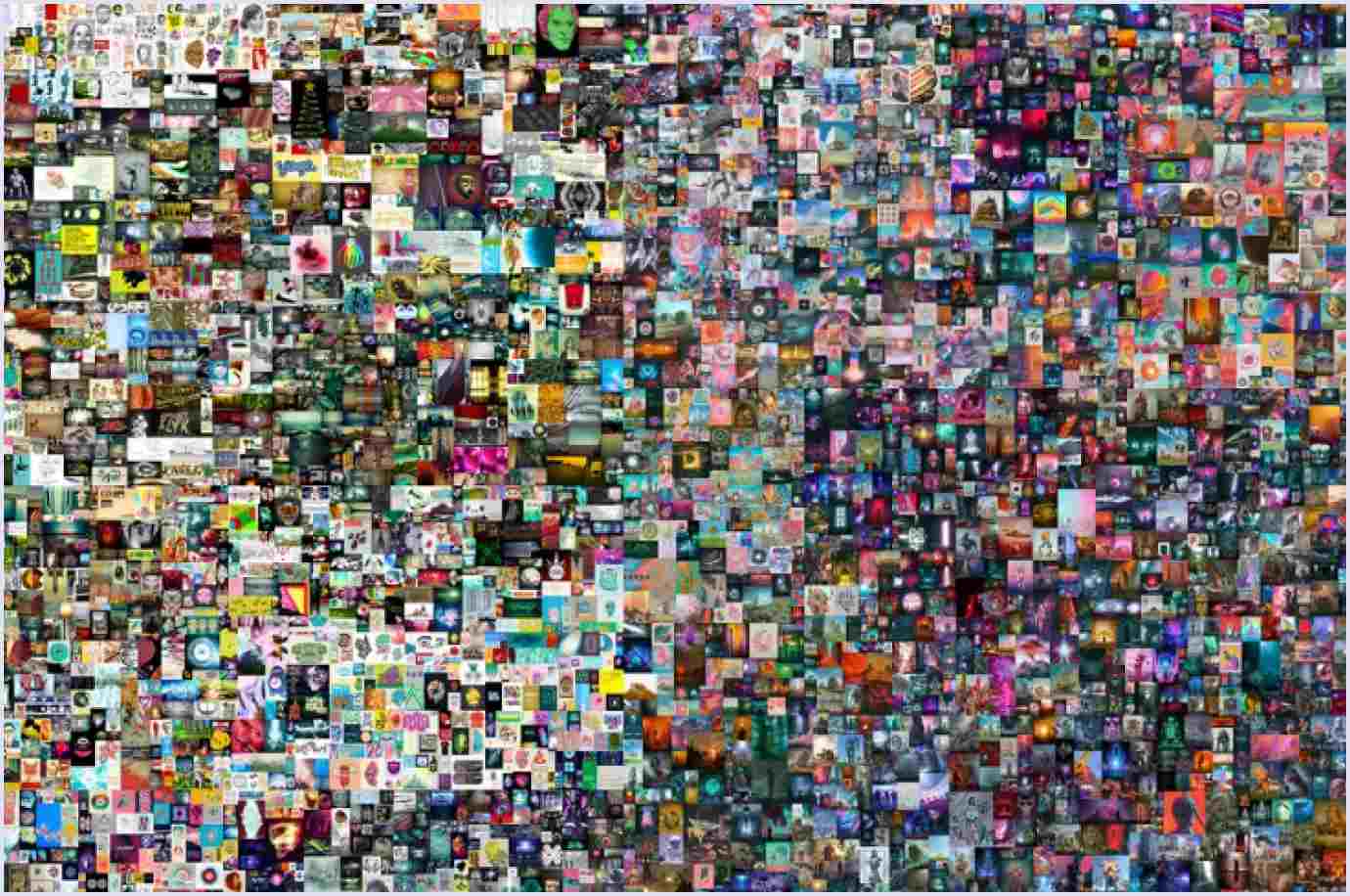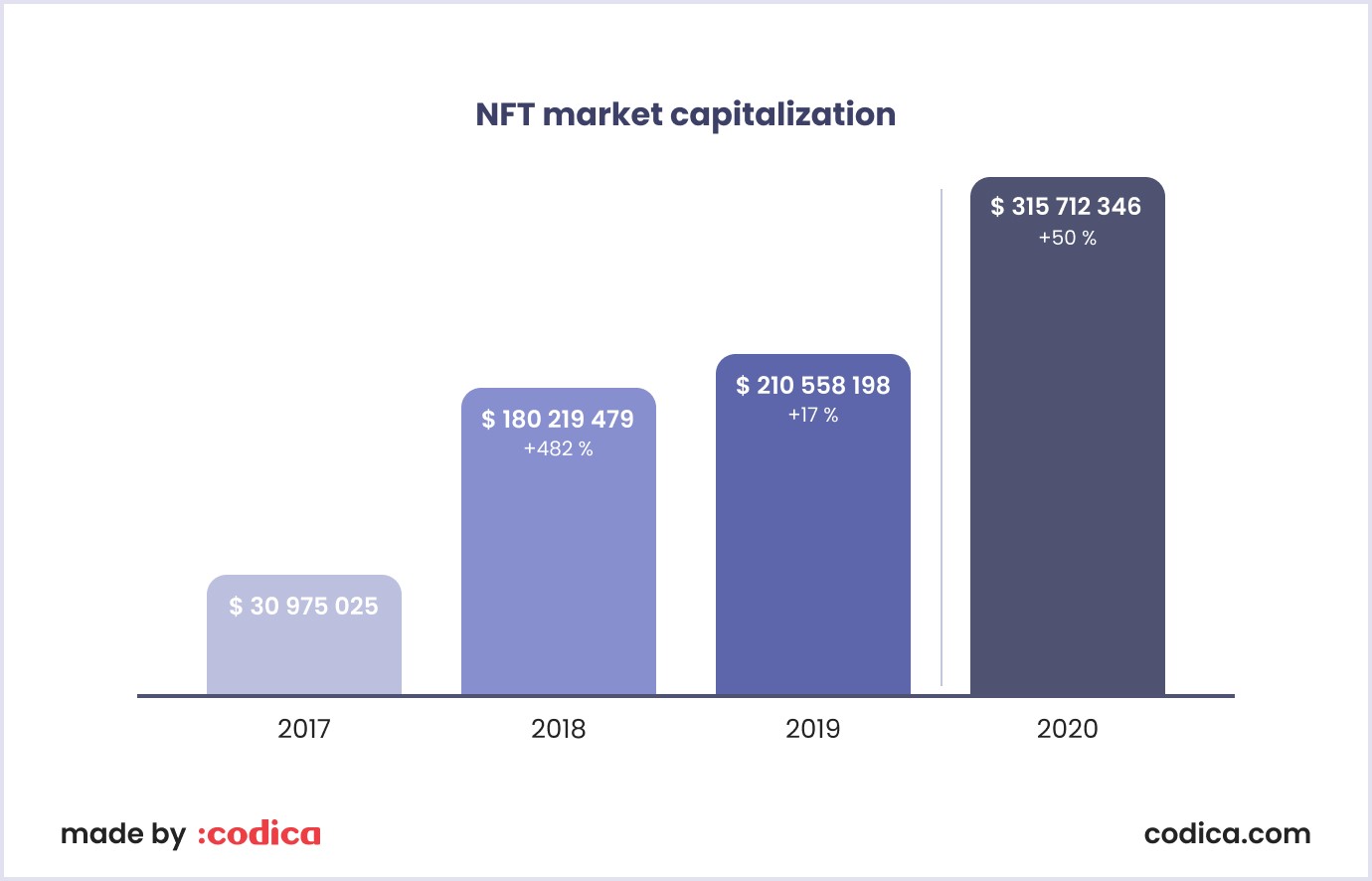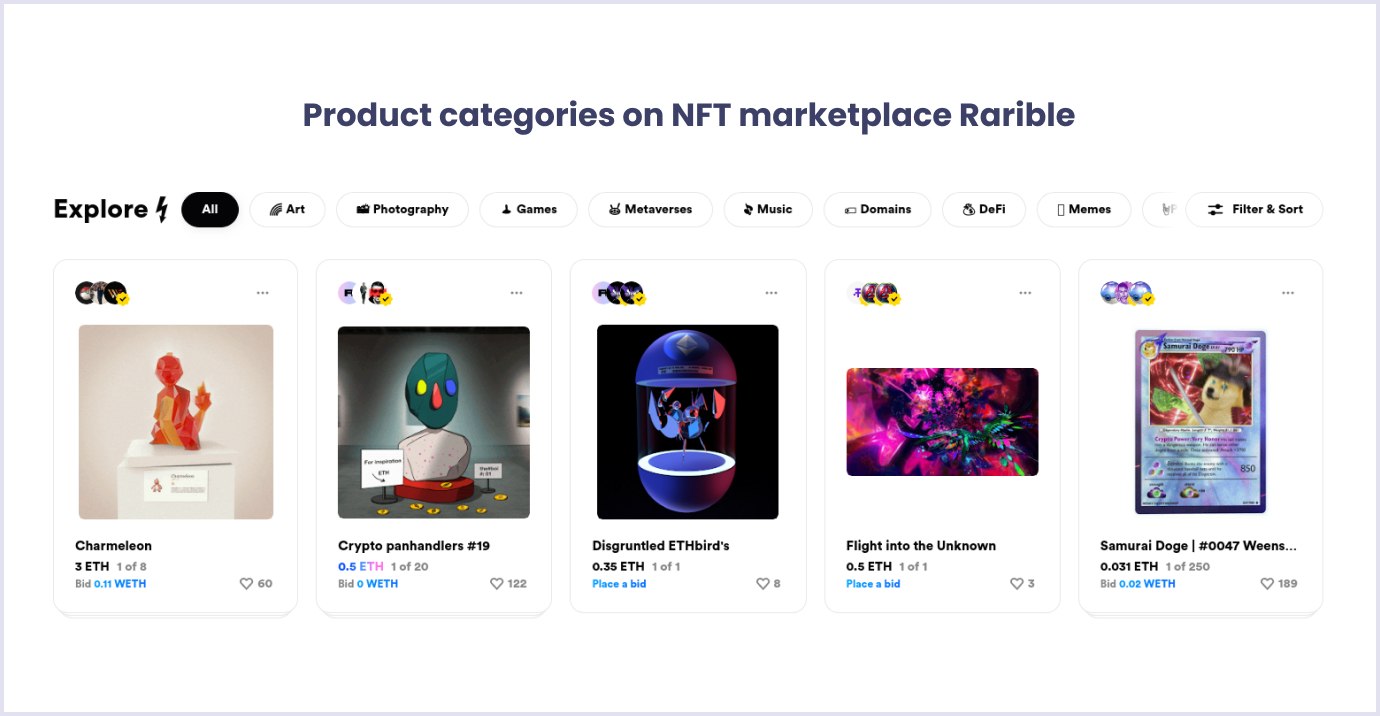The outbreak of COVID-19, followed by the lockdown, has forced museums and galleries to close. As a result, the sales of physical art have dropped dramatically. Token-based art sales, vise versa, have taken off, hitting $8.2 million in December 2020. By comparison, in November 2020, the corresponding figure was $2.6 million.
What’s in it for you? The point is that the NFT market is growing by leaps and bounds. It’s up to you to decide how you can benefit from this trend. The launch of an NFT e-commerce platform is one of the possible opportunities.
Do not get upset if it is a “terra incognita” for you and you are at a loss where to start. We are here to help. In this article, we will define the term “NFT marketplace” and discuss the core aspects of NFT marketplace platform development.
What is a non-fungible token (NFT)?
The term “non-fungible token,” or NFT for short, refers to a piece of digital content linked to the blockchain. These can be texts, images, digital artworks, audio recordings, domain names, trading cards, and in-game items.
Each NFT item is unique, and we cannot replace it with another object. That is why we call such assets “non-fungible tokens.”
Basically, NFT tokens work on the Ethereum blockchain, and the ERC-721 standard is used for their creation. The standardization of the NFT issuance ensures a higher degree of interoperability which is the ability of blockchains to interact with each other. As a result, these non-fungible tokens can be transferred between various decentralized applications.
The specific properties of NFT tokens
- Indivisibility - we cannot divide non-fungible tokens into smaller parts.
- Authenticity - it is easy to verify the information about a token and its owner.
- Non-interoperability - since each token is unique, you cannot exchange these items.
- Tradability - NFTs can be traded on different crypto marketplaces. Thus, their holders can reap benefits from these advanced trading systems. Bundling, bidding, and the possibility of selling in markets offer endless opportunities to NFT owners.
- Interaction with multiple ecosystems is possible owing to ERC 721 Token and its better version ERC 1155 Token. These two standards allow the creation of NFTs for digital collectibles.
- Liquidity. The fact that non-fungible tokens can be traded instantly increases their liquidity. The target audience on different NFT marketplaces may vary from rookie players to hardcore traders. It means that digital assets are exposed to a greater pool of buyers.
- Programmability. Non-fungible tokens are fully programmable, just like any other digital asset. Today’s NFTs are often associated with complex mechanics, which may include crafting, forging, and random generation. The design space has endless possibilities.
- Scarcity. Thanks to smart contracts, developers can put hard caps on the supply of NFTs. Coders can enforce specific properties that cannot be altered after their launch.
Let’s take a closer look at the last quality from the list. The term “scarcity” points out the shortage of products available on a marketplace platform. As for NFT websites, developers can use this tactic by enforcing a limited edition of a specific NFT crypto asset programmatically. Meanwhile, the supply of ordinary objects remains infinite.
This tactic is often used when selling digital art items. The thing is that scarcity of original objects is crucial for this domain.
NFTs: the best-known examples
Game characters
A good example of early NFTs are CryptoKitties that are collectable, breedable, and cute digital creatures. They appeared in 2017 as main characters of the same-name blockchain game. It was one of the first tries to use blockchain technology for leisure and fun.
Texts
Surprisingly enough, tweets can be classified as text NFTs. By the way, did you know that Twitter founder Jack Dorsey put his first tweet on sale? It was recently sold for $2.9 mln on a platform called Valuables.

Sport
When it comes to non-fungible tokens, sport did not stay on the sidelines. Thus, the NBA decided to launch the line of digital collectibles and hit it big. The line has already generated $400 million in trading.

Digital artworks
The last but not the least non-fungible token we would like to show is considered currently as the most expensive NFT piece. It is collage by digital artist Beeple called “Everydays - The first 5000 days”. This artwork was sold for astonishing $69 million at the British auction house Christie’s.

The NFT ecosystem: key findings
We have discussed the term “non-fungible token” and its specific characteristics. Now we suggest that you take a look at a brief overview of the non-fungible token ecosystem.
Below you can see the key takeaways from the Non-Fungible Tokens Yearly Report 2020. This data will help you understand what is going on in the NFT market and why you should care.
- The total number of active wallets that performed NFT transactions has grown by 97%, reaching 222,117.
- The number of buyers who purchased at least one non-fungible token was 74,529
- The number of sellers of NFT tokens was 31504. The corresponding figure was
25,264 in 2019.
- The total value of non-fungible token transactions has grown by 299% and exceeded $250 million.
Finally, let’s take a look at such an important indicator as the NFT Market Capitalization.
The chart below shows how the total number of assets present on the market has been changing from 2018 to 2020.

Source: Blockonomi
Overview of the NFT marketplace domain
An NFT marketplace is a dedicated platform for storing and trading non-fungible tokens. Items either have a fixed price, or can be bought at an auction.
It is worth noting that buyers should have a crypto wallet to carry out transactions.
Types of NFT marketplace platforms:
- Universal non-fungible token websites sell any kind of crypto goods, be it a work of digital art or a domain name. What are the most well-known universal NFT websites? These are Rarible, OpenSea, and Mintable.
- Niche peer-to-peer marketplaces are focused on offering particular digital assets. You have probably heard about Valuables, a website where you can buy and sell tweets. Another example is Glass Factory, where digital holograms are sold.
The most well-known NFT marketplaces are Rarible, OpenSea, and Atomic Market.
How does an NFT platform work?
Definition of a smart contact
A smart contract is a self-executing transaction protocol, or a piece of programming code, to put it simpler. This code is used for inputting all the terms of the agreement concluded between the parties to the transaction in the blockchain.
What makes this transaction protocol so important? The thing is that it regulates relations between sellers and buyers on NFT marketplaces.
How does smart contract work?
Obligations of parties are represented in smart contacts in the form of if/then. For example, if a buyer transfers the payment for a digital item, then a seller grants the right to this NFT crypto asset. Provided that the condition is met, the smart contract conducts the transaction independently.
To sum up, the table below displays the main difference between smart contracts and traditional ones.

So let’s get back to NFT marketplaces. Non-fungible tokens are implemented via smart contracts. Each item comes with unique metadata. This set of specific information related to supply, provenance, and authenticity is written in smart contracts. Blockchain technology carefully protects this data.
For a token marketplace development, we need to create a token protocol. As a rule, these protocols are created on the Ethereum network, which is a particular group of smart contracts. They enable the implementation of certain marketplace functionality. Later on, token protocols will be integrated in the process of NFT marketplace development.
The user flow on an NFT marketplace
Now let’s discuss how NFT marketplaces work for users. Here we should say that the flow is similar for all non-fungible auction websites.
- Step 1. Users register an account on an NFT platform
- Step 2. Setting a crypto wallet is required.
- Step 3. Here comes the NFT creation process. For this purpose, users upload digital items to showcase their work.
- Step 4. Users list items for sale. Here they have two options: choosing a bid for an auction or setting a fixed price.
- Step 5. Items pass moderation.
- Step 6. As soon as new NFTs are approved, potential buyers can see it in the list for sales.
- Step 7. The tokens’ owner can start accepting bids.
- Step 8. When the auction closes, sellers are notified about top bids.
- Step 9. The NFT platform regulates the transfer of digital assets and funds.
Schematically, user flow on on an NFT platform can be presented the following way:

How to create an NFT marketplace?
We have described the key features of non-fungible token platforms, their types, and functioning. Now it is high time to proceed to the NFT marketplace development process.
When it comes to the business part, it remains the same as for any other software product. You need to define the right audience for your platform and the challenges you are going to solve with its help.
Then, you should select the must-have functionality for your NFT marketplace and find the most suitable development approach.
Basic functionality for an NFT website
What functionality for your crypto marketplace should you implement in the first place? Your primary task is to allow users to create and sell collectibles. Then, extra features can be added to offer website visitors an excellent user experience.
We would recommend that you proceed from the following features:
- Storefront. Like any other marketplace, your NFT marketplace platform should have a storefront.
- Convenient search. Make sure that users can easily find a collectible of their interest. It would be a good idea to divide all assets into several categories such as Art, Photography, Domains, Memes, Music, etc.
Below you can see product categories at the non-fungible tokens marketplace Rarible.

- Filters. The system of filters will help users to navigate your NFT app and select the required items. With this feature, the time between the NFT selection and purchase will be significantly reduced. Popular filters include Highest Price, Lowest Price, Recently Listed, and Most Viewers.
- Listing creation. The process of creating a collection should be straightforward and fast. On the creation page, users should be able to upload a file and enter the required token information such as name, description, and tags.
- Listing status. This feature will be beneficial for sellers going through the collectible verification process. With its help, they can check the stage of the verification process for their items.
- Buying and auction. Building a convenient auction system is one of the key stages of NFT marketplace platform development. Do not forget to set the expiration date in the form. This way, you will grant users additional control over their bids. Besides, with an auction watchlist, users can track the current status of the bids.
- Ratings. This feature will be helpful for new users who do not know what NFT to choose. Besides, you can use them to reward the best sellers and prove their reliability.
- Wallet. With this functionality, sending, storing, and receiving cryptocurrencies and non-fungible tokens becomes possible. For convenience, enable the NFT marketplace users to connect their preferred wallet.
For example, OpenSea providers users with an opportunity to connect various wallets:

The functionality for a non-fungible tokens marketplace is not limited to the features discussed above. You can try and add some unique functions to enhance the user experience. For example, you can build a strong community on your platform by creating a forum.
Also, it would be a good idea to implement a push notification system. It will inform users about new collectibles or the current status of their listings.
Ready solutions vs custom marketplace development
We have defined the required functionality for your NFT marketplace. It is high time to talk about the technical implementation of your project. So how to create an NFT marketplace? Let’s find out.
When it comes to creating an NFT platform, you have two available options. First, you can use ready-made tools for the NFT marketplace development. This option will be less expensive. Besides, you can benefit from shorter time-to-market.
As an example of such solutions, we should mention the SDK offered by OpenSea. With this tool, you will get an NFT marketplace with OpenSea’s infrastructure and your unique design.
Alternatively, you can use the services of a reliable custom software development company. Their specialists know how to create an NFT marketplace that will satisfy all your specific requirements.
With this approach any new functionality can be added per request. So you will not have any problems with scaling and enhancing your platform for getting more users.
Another advantage of custom software development lies in careful protection of the sensitive information. It is especially important for non-fungible tokens marketplaces where failures to comply with the security laws can have negative consequences.

How much does it cost to build an NFT marketplace?
We have now to come to an interesting and tricky topic, which is the cost of building an NFT marketplace. In a nutshell, everything depends on the amount of work required. For example, if you decide to use a ready-made solution that is ready to be installed, the cost will be lower.
At the same time, NFT marketplace development services of a reliable software development house will be more expensive. The reason is that their specialists will have to build a user flow, develop the functionality, and design your solution from scratch.
Same goes for the platform functionality. The more complex platform you want to build, the more money you will have to invest in marketplace development.
For your convenience, we created a table showing the correlation between the functionality of an NFT marketplace and its cost.
| NFT marketplace development cost | ||
| Features | Time, hours | Cost, $50/hour |
| Design | ||
| UX Development | 42 hours | $2,100 |
| UI Development | 64 hours | $3,200 |
| Architecture | ||
| Project setup | 16 hours | $800 |
| DB structure | 32 hours | $1,600 |
| Integrations | ||
| Payment (Stripe or PayPal) | 64 hours | $3,200 |
| Main functionality | ||
| Authorization and Security | 72 hours | $3,600 |
| User Profiles | 42 hours | $2,100 |
| Home page | 84 hours | $4,200 |
| Search and filters | 96 hours | $4,800 |
| Product page | 42 hours | $2,100 |
| Reviews & Ratings | 48 hours | $2,400 |
| Shopping cart | 48 hours | $2,400 |
| Payments | 42 hours | $2,100 |
| Notifications | 32 hours | $1,600 |
| Etherium integration | 128 hours | $6,400 |
| NFT management | 128 hours | $6,400 |
| Inventory management | 128 hours | $6,400 |
| Buyer panel | 64 hours | $3,200 |
| Author panel | 132 hours | $6,600 |
| Admin panel | 85 hours | $4,250 |
| Non development activity | ||
| Project management | 64 hours | $3,200 |
| Quality assurance | 80 hours | $4,000 |
| Code review | 48 hours | $2,400 |
| Total | 1581 hours | $79,050 |
So, if you wonder about NFT marketplace platform development costs, the prices start with $79,050. Be aware that the cost will be higher if you want to use the services of developers from Western Europe or the United States.
Besides, you should be aware that the total price will be defined by your specific business requirements.
How can Codica help with NFT marketplace development?
Since 2015 Codica team has been creating user-friendly and robust e-commerce platforms. We adhere to the latest marketplace development trends. This way, we guarantee that our solutions are SEO-optimized to bring our customers high traffic and increase sales.
When building custom marketplace platforms, we use the most advanced technology stack. This way, we ensure the reliability, scalability, and security of the products we deliver. Thus, we have recently gained valuable experience in dealing with the blockchain. We firmly believe that it is a promising tool for many fields of business.
To share our best practices in this field, we want to discuss our recent project where this technology was successfully implemented.
Case study: Babel Cover
We got a request from Babel Cover, which is an insurance technology startup. The company is engaged in creating personal insurance products. Their purpose is to encourage users to build low-risk profiles.

Our team was requested to build a progressive web application that would allow users to purchase an insurance policy in the most convenient way. With the PWA approach, the customer could save costs on mobile app development and launch the product much faster.
The big challenge that came up with this project was to provide users with ultra-secure data storage and payment processing. The sensitive information as well as access to the private e-wallets where rewards are held should be available for customers only.
Providing insurance software development services, we addressed this challenge by integrating a custom blockchain solution via API.
Now the insurance company can view personal data that belongs to customers only if they face some issues with the withdrawal of funds.
Owing to this integration, the PWA solution we have delivered is a great example of a reliable web solution for the insurance industry.
For more information about the project and technical solutions we implemented, read the full case study.

Final thoughts
Today non-fungible tokens draw more and more attention. They raise great curiosity among vivid collectors striving to gain unique digital objects. For this reason, starting an NFT business seems a promising venture for early adopters.
However, it is crucial to understand how NFT marketplaces are different from other e-commerce platforms. This way, you increase your chances to succeed with a unique platform that passionate fans of digital art will love.
If you decide to invest in online marketplace development, do not hesitate and contact us. We will eagerly take up your project.

